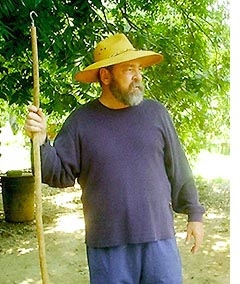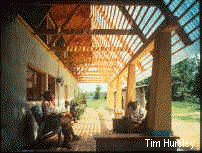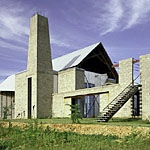 |
| Samuel Mockbee in front of the Yancey Chapel |
"In almost everything that he did, his own personal welfare was the last thing that he thought about. He would literally give you the shirt off his back." -- Daniel Bennett, School of Architecture Dean, Auburn University
Born Dec. 23, 1944, and raised in the deep South, Samuel "Sambo" Mockbee was surrounded by extreme poverty. It affected him deeply and he vowed to use his skills as an architect to change things.
In 1974, Mockbee graduated Auburn University in Alabama with an architecture degree; by 1984, he was a partner in the successful firm of Mockbee/Coker. Never forgetting his social conscience, he and his partner, Coleman Coker, designed a series of "charity houses" for poor families. The project won a 1987 Progressive Architecture Award, but the homes were never built. This setback, however, would not deter Mockbee.
In 1993, now a full professor at Auburn University, Mockbee established a revolutionary teaching/community service program called The Rural Studio. Under the program, Auburn University architecture students design and build homes and community buildings for the poorest residents of rural Hale County, Alabama. The budget for each construction is small--about $30,000--and the students build the houses using whatever materials they can get their hands on: tires, railroad trestles, old pieces of tin, etc.. There's even a church, the Yancey Chapel, that is made of tires filled with dirt and covered in stucco.
 |
| The Rural Studio dormitory pods |
In addition to building homes for others, the students also built their own "dormitory" (a series of pods largely constructed of old license plates and street signs). It was important to Mockbee that the students actually live in the community they were building. "Architecture should be about giving people places to live, instead of creating monuments to yourself," Mockbee said in an interview with American Profiles reporter Elizabeth Via Brown. "Kids who want to be architects should be out there learning about the people they'll be working for."
 |
| The Hay Bale House |
Shep and Alberta Bryant were Rural Studio's first clients. They live in the "Hay Bale House," so named because its 24-inch-thick walls are built entirely of hay bales covered in stucco. Bryant is proud of his home and regularly gives tours of it. "It's a fine house," he says. "You're always welcome to come and see what these children did."
In 2000, Mockbee was awarded a coveted MacArthur Foundation "Genius Grant" worth $500,000. With a modest humor friends say was typical of him, Mockbee commented, "I'm no genius, but I'm smart enough to take the money." All of the money would go to the Rural Studio project.
 |
| The AIA award-winning Cook House |
While his public battle against poverty was gaining momentum, Mockbee's private battle with leukemia threatened his life. His first bout occurred in 1998, and on Dec. 30, 2001, the disease took Samuel Mockbee's life. He died in a Mississippi hospital at the age of 57.
Though Samuel Mockbee is no longer with us, his vision lives on both through Auburn University, which plans to continue and strengthen The Rural Studio, and through Mockbee's students, such as Steve Hoffman. "Whatever I do as an architect will have to have social responsibility," Hoffman says. Mockbee's colleague, R.K. Ruth, summed up his good friend's life in one simple statement: "The world is a better place because of Samuel Mockbee."
Page created on 10/16/2007 7:28:39 AM
Last edited 8/9/2018 9:03:03 PM
"Mockbee Southern Genius." Katauskas, Ted. Architecture Week, Aug. 23, 2000.
"Mockbee's Masterpieces." Via Brown, Elizabeth. American Profile, Aug. 27, 2000.
"Samuel Mockbee: A Design for Life." Sittenfeld, Curtis. Fast Company, 2002.
"Building Blocks of Change." Roux, Caroline. Guardian, April 20, 2002.
The Rural Studio Web site / The Auburn University Web site.
